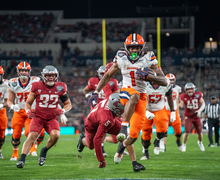Graduate students, faculty publish academic integrity book
One school year after graduate students represented the largest group of academic integrity violators, the Syracuse University Graduate School published a book through its Graduate School Press on teaching academic integrity.
The book, titled ‘Pedagogy, Not Policing: Positive Approaches to Academic Integrity at the University,’ is a compilation of 19 articles written by graduate students and faculty at SU and other universities. Published this past February, it is intended to be a guide for new professors and teaching assistants on how to prevent and handle academic dishonesty by undergraduate and graduate students, said Holly White, an editor of the book.
It’s the fourth part of a five-book series of guides to teaching strategies, she said. This one was written in reaction to SU’s university-wide academic integrity policy, which has brought more violations to light since its implementation in 2006, White said.
White, a Ph.D. student in religion, said that after the new regulations started, she and the other editors started searching for papers about people’s experiences. They hoped to emphasize teaching over punishment when it comes to academic integrity, White said.
‘As a graduate student, as a TA myself, the things that I would be looking at through this book are, ‘How do I promote academic integrity through the design of my teaching, through the course’s curriculum, through the methods that I use to teach the content?” White said. ‘For example, if I’m going to be talking about sources and how to cite sources, that’s a way to talk about what kind of content is important to learn and how they can integrate that content into their own writing.’
During the 2007-2008 school year, there were 130 academic integrity violations, up 2 percent from the previous year, according to the Academic Integrity Office’s annual report.
The most commonly broken policy, with 85 reported violations, was in course work and research. The Academic Integrity Office defines this as cheating during an exam, copying other students’ work or submitting the same paper for more than one class.
Graduate students represented the largest group of violators with 44 students, or 34 percent of overall violations. Graduate students make up one third of the population at SU, so it follows that they would make up about one third of academic integrity violations, said Patrick Wilcox, president of the Graduate Student Organization.
Wilcox said he found SU remains consistent with other schools when he conducted research in academic integrity violations.
While the book is aimed at new professors and teaching assistants, White said older professors may also find it helpful to adapt their curriculum to the 2006 Academic Integrity Policy.
‘For years, people have been putting an academic integrity statement on their syllabus and perhaps only reviewing that statement at the beginning of the course,’ White said. ‘But, if there’s a university-wide policy, the instructor may want to take some time to review how plagiarism looks in their particular department.’
Articles in the book focus on academic integrity within a specific discipline in ‘The Dreaded Laboratory Report’ by Danielle Schuehler, a graduate student in chemistry who draws from her own experience writing lab reports. Schuehler recommends that teaching assistants explain the theory behind the labs as simply as possible so that students do not feel overwhelmed.
White said the book also acknowledges that students commit academic dishonesty when they are stressed and emotional. She said the book talks about ways to create educational environments that reduce stress in articles like ‘Temptations in the Large Lecture Class: Concrete Measures to Help Students Practice Academic Integrity’ by Sarah Bolton, a graduate student in chemistry.
‘People want to cheat because they feel there’s no way out,’ White said. ‘It’s kind of a shortcut. But there are ways instructors can design tests. There are ways that instructors can design testing environments that reduce the test-taking stress, and that preserves the integrity of the teacher.’
Published on March 22, 2009 at 12:00 pm





